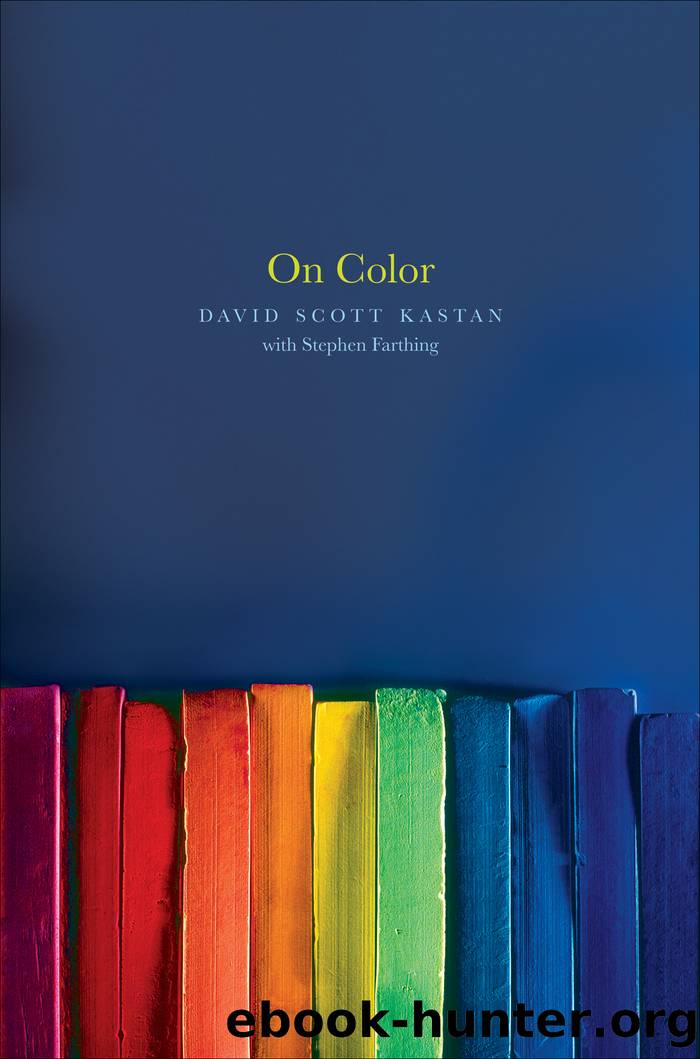On Color by David Kastan Stephen Farthing

Author:David Kastan,Stephen Farthing
Language: eng
Format: epub
Publisher: Yale University Press
Published: 2018-07-15T00:00:00+00:00
FIGURE 28: An indigo plantation in the Antilles, in Jean Baptiste du Tertre, Histoire générale des Antilles habitées par les François, vol. 2 (Paris, 1667)
Nothing is visible here of Bernard Romans’s account of the difficulty and “inconvenience” of growing, cultivating, and processing indigo as it is turned into a dye—and there is no sign of intimidation, except perhaps for the owner’s walking stick, which could so easily be turned into a switch. The engraving gives no indication of the overwhelming stench or swarms of insects that Romans mentions, no suggestion at all of the oppressive “fatigue of a southern plantation” that Romans had noted, even if in this case Romans has silently transferred that “fatigue” to the plantation from the bodies of those who actually endured it. He does admit that it is an exhaustion that white men could not tolerate, but he seems certain that slaves do not feel it, as they are accustomed to the “similar work in their own sultry country”—two related “facts” he musters as part of his defense of the logic of slavery.26
Romans, even in his overt racism, is so much more honest than the engraver. Indigo plantations were punishing factories, not serene farms. The slaves lived in squalor and were often malnourished. The work was taxing and unsafe. What was most dangerous was encountered mainly in the production of the dye rather than in the cultivation of the plant. Slaves would sometimes be forced to stand in the pools of fermenting plant matter, agitating the mixture with their hands or their own marching. They were exposed not only to the extreme heat from both the sun and the fermenting material itself but also to the harmful fumes that were released. The vat was, therefore, sometimes known as the “devil’s tank” (and indigo itself had been called by many the “devil’s dye,” although this was a name earlier given to it by European woad producers mainly to discourage the foreign competition from indigo—but the shoe fits).27 Even when the indigo residue was at last removed from the bottom of the vat and set out to dry, then “young Negroes,” as Romans says, often girls, were “employed in fanning the flies out of the drying shed, as they are hurtful to indigo,” though he is unconcerned that the great swarms of disease-carrying insects, which he had earlier acknowledged were also “hurtful” to the farm animals, might in any way be hurtful to the slaves.28
What was true in Florida in the middle of the eighteenth century was true wherever indigo was produced on any scale. In the Caribbean and the American colonies, it was the enslaved Africans who made possible the production of the dye; in Central and South America, it was the indigenous inhabitants who worked under various regimes of harsh regulation. And later in India, it was peasants who were abused and sometimes starved by wealthy British planters, who often forced them to plant indigo instead of food. There are lots of stories from around
Download
This site does not store any files on its server. We only index and link to content provided by other sites. Please contact the content providers to delete copyright contents if any and email us, we'll remove relevant links or contents immediately.
The Art of Thinking Clearly by Rolf Dobelli(8836)
Mindhunter: Inside the FBI's Elite Serial Crime Unit by John E. Douglas & Mark Olshaker(7827)
Change Your Questions, Change Your Life by Marilee Adams(6637)
Nudge - Improving Decisions about Health, Wealth, and Happiness by Thaler Sunstein(6629)
Mastermind: How to Think Like Sherlock Holmes by Maria Konnikova(6225)
The Power of Now: A Guide to Spiritual Enlightenment by Eckhart Tolle(4749)
Men In Love by Nancy Friday(4314)
Factfulness: Ten Reasons We're Wrong About the World – and Why Things Are Better Than You Think by Hans Rosling(4015)
The Confidence Code by Katty Kay(3561)
Thinking in Bets by Annie Duke(3527)
Man and His Symbols by Carl Gustav Jung(3309)
Three Women by Lisa Taddeo(2916)
The Worm at the Core by Sheldon Solomon(2910)
Why Buddhism is True by Robert Wright(2820)
Liar's Poker by Michael Lewis(2805)
The Inner Life of Animals by Peter Wohlleben(2763)
Descartes' Error by Antonio Damasio(2728)
The Power of Mindful Learning by Ellen J. Langer(2705)
The Slow Fix: Solve Problems, Work Smarter, and Live Better In a World Addicted to Speed by Carl Honore(2570)
